Designed to Heal our Eyes and Hearts
By Donald Brackett, WTP Guest Writer
Time Shadow, The Ambient Paintings of Bernadette Jiyong Frank. July 9 – August 29, 2020, Dolby Chadwick Gallery, San Francisco.
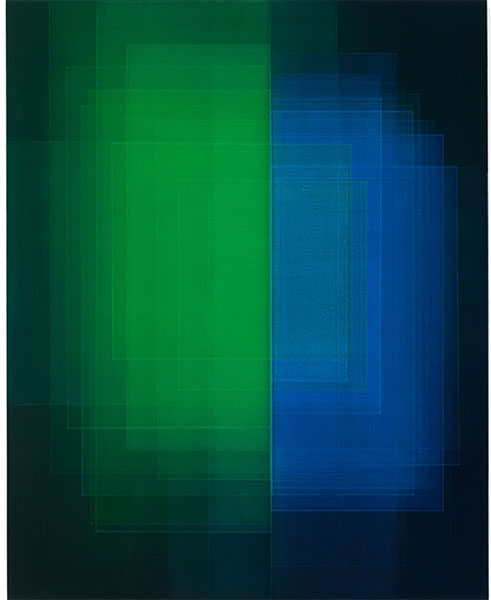
This remarkable body of work by Jiyong Frank, in its harmonious entirety, is the opposite of the hyper-speeds of technology and celebrates a perceptual slowness at the heart of all true seeing. In almost every single painting the actual subject and theme is the transmission of light and its impact emotionally on the viewer. Actuality shines through. Aura and affect are utterly unified in this suite for illuminated inner colors, a temporal sequence which is both meditative and aggressively active simultaneously. In fact, one of the many charms of these works is how they function as floating constellations which orbit and interact with each other as structural units in a larger scale drama. The themes unfold in almost shocking unison and are predominantly focused on time, color, and light as executed in a carefully crafted minimum of means for maximum effect. Time and its seasonal disguises are explored delicately, as in the magnificently liminal diagram of duration called “Refraction”, but also with considerable vigor and verve, as in the more boldly declarative drama of “Refraction Diptych.”

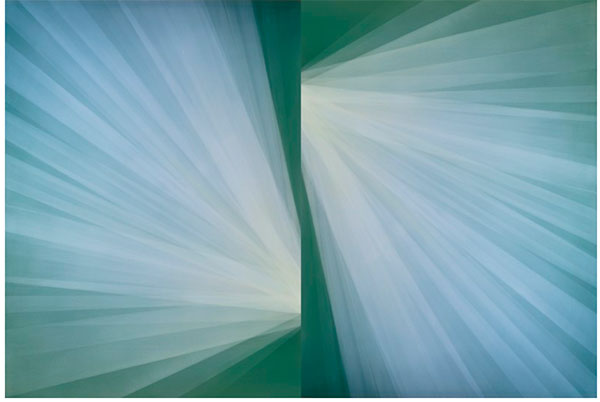
I first encountered Jiyong Frank’s highly contemplative works, which are time consuming to produce and require slow observation to properly appreciate, when I was writing an article for a Buddhist magazine called Lion’s Roar on the subject of music as a tool for support during meditation. It was a propitious moment for me, since I was also speculating on the historical use of visual aids to concentration, images such as mandalas, to help focus the mind and heart on the motive of forgetting. I was subsequently exposed to another quiet body of her work which was used to illustrate a similar writer’s evocation for another Buddhist magazine called Tricycle, for which I’m also coincidentally planning an article.
In the piece by Kurt Spellmeyer, a Zen priest and director of the Cold Mountain Sangha in New Jersey, he drew our attention to the wisdom of uncertainty and the power of liminality, the kind of threshold experiences so well depicted in Jiyong Frank’s overall work. He stressed in his examination of the famous Diamond Sutra that our confusions often lead us to believe that our problems are “out there” in the world of forms, when actually the culprit is our mind’s tendency to make everything appear “permanent and independent of everything else.” But that Sutra invites us to consider that liminality, a kind of interstitial in-betweenness, is actually the way things really are, which of course entails embracing uncertainty as not just a fact but as a way of life.
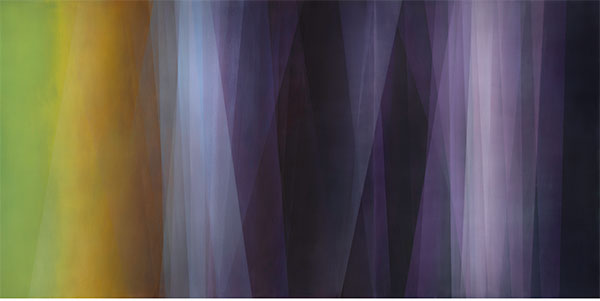
After the loud and raucous period of the 1950s and ’60s, when amplified music reached a sort of peak beyond which the human ear could not follow, several composers and musicians, some of them even emerging from the pantheon of rock itself, began to explore a more contemplative realm. They called it ambient music. The most gifted among them, Brian Eno, also termed what he did discreet music, or thoughtful music, sounds which weren’t meant to demand our entire attention but allowed us instead to rest calmly, even mindlessly, in their sonic spaces.
Likewise in the art of painting, and parallel with the passionately emotional plunges of a Pollock or de Kooning, in the ’40s and ’50s there arose concurrently a sedate and meditative theater of subliminal seeing inaugurated so skillfully by artists such as Rothko and Stella. The deceptively simple paintings of later Kelly and Reinhardt also ushered us into a domain we can accurately identify as that of ambient painting. So too, Jiyong Frank has chosen to explore these fragile ethereal zones in between the solid and the fluid, the seeing and the seen, the visible and the invisible.
Can paintings ever be like a kind of homeopathic medicine designed to heal our eyes and hearts? These works of Jiyong Frank’s appear to be just that. They take aspects or elements of nature, such as those of the landscape, of light, of horizons, of ice, of fields, of fog, of water, but rather than representing them directly or literally they use their essential or even spiritual raw materials to construct phenomenological experiences of transcendence. Ambient painting is not aggressive but that doesn’t mean it’s passive. On the contrary, her ambient paintings are so quietly powerful that they wait patiently for us to be strong enough to share them properly while in their company. And these paintings are so patient.
In “Duality” for instance, this particular painting strikes me as having discovered a zone of perpetual becoming, since time’s passage is also its saturation and its evaporation. Jiyong Frank’s elusive works in her Time Shadow series also bring us close to the classical Japanese insight of Ma, the subtle pause between events, moments, forms, and thoughts which provides our ongoing reality with its distinctive layered aspect. It is that apparent gap which permits us to witness the marvelous interconnectedness of all things, if that is, we are ready to do so, which requires us to transcend duality.
Her translucent images consist of hundreds of separate layers of paint, applied daily in a kind of visual diary, which form a seamless whole of almost musical intervals. As the artist has noted, it is the space between the layers that gives her paintings their visceral depth, much the same way the silence between notes in combinations known as chords make music occur.
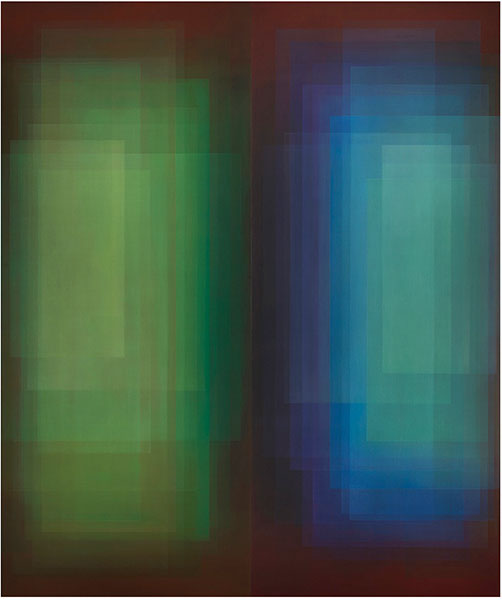
These paintings do indeed feel like optical singing to me. The eyes listen to them like splendid durational depictions in which any traditional figure and ground relationships are merged and become virtually indistinguishable.
She is thus a purveyor of thresholds at play in the field of vision where Sunyata, a Sanskrit word for emptiness, suddenly comes abruptly into focus. For Buddhists, Sunyata denotes a completely open and unbounded clarity of mind best characterized by groundlessness and freedom from all limited conceptual frameworks. Sunyata is what the sublime would look like if we weren’t around to get in the way by expressing our astonishment at its beauty. Perhaps this is beauty at the archetypal or emblematic level, as shown so ideally in a splendid group titled Migrant, (one burgundy, one blue, one green, one orange, one red, and one chartreuse version) which capture our attention and then release us a moment later. They do appear to migrate from meaning to knowing, and then from wondering to dreaming, right before our waking eyes. In the end, the camera has to submit and surrender before these visions, unable as a mechanical tool for reproduction to ever fully render their haunting subtlety. Only the human optic nerve, placed before them for a prolonged period of time, might do them justice, perhaps allowing time’s shadow to slowly emerge from its hiding place.
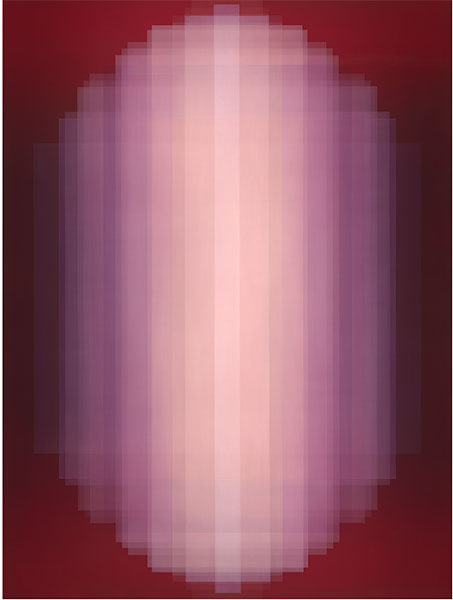
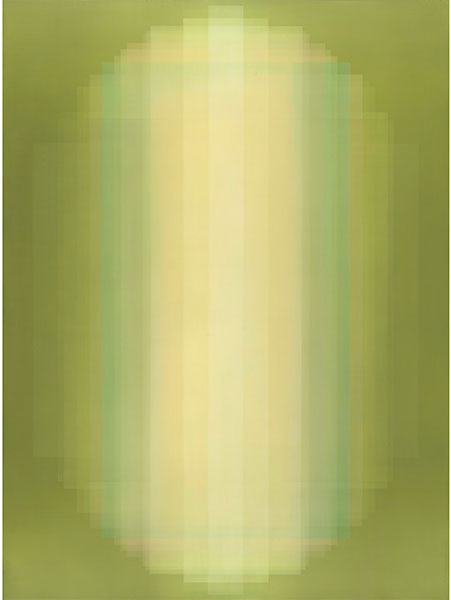
While partaking in the nourishment of her luscious paintings, I was also reminded of an insight provided by a favorite writer, Lawrence Durrell, someone who shared my interest in the spaces between both words and images: “The solace of such work as I do lies in this—that only there, in the silences of the painter or the writer, can reality be reordered, reworked and made to show its significant side.”
Bernadette Jiyong Frank was born into a Korean family in Tokyo, Japan, in 1964. She moved to the San Francisco Bay Area as a young teenager and then to Los Angeles, where she later studied at the Otis Art Institute of Parson School of Design and the nearby Art Center College of Design in Pasadena. Her work has been exhibited across the United States and Germany and has been acquired by the Crocker Art Museum, Sacramento. Time Shadow is her second solo exhibition at the Dolby Chadwick Gallery, San Francisco, from July 9–August 29, 2020.
Donald Brackett is a Vancouver-based culture critic who writes about visual art, design, music, and films, as well as being a curator for Cinematheque. He is the author of numerous review articles, exhibition essays, and books on visual culture, and is currently working on a new biography on the life and art of Yoko Ono.
Want to read more of our exhibition reviews? Click here.
